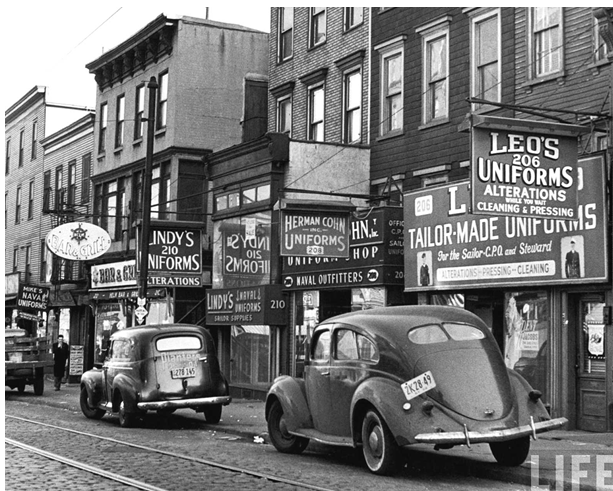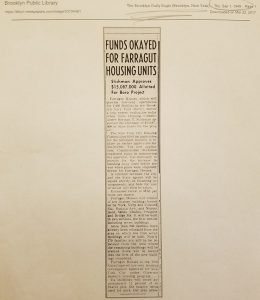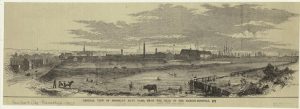I found this article that was written by The Brooklyn Daily Eagle on September 1, 1949. The article is about the Farragut Housing Low Income housing. I find it interesting that 15 million dollars was placed on this “Boro Project”. Although it seems like a huge investment I wonder who was for the benefit for? The residents? Brooklyn? The government? No one? I remember in class we saw a documentary of similar low income housing in Tennessee I believe. I remember that housing failed and was demolished at the end. Having that in mind If the low income housing didn’t work then why make more. Sure the low income housing provides people with needs with a home for a low amount. In the article it states that the estimated price for every room would be about $8.82. It makes me wonder if the low income housing are the reason it degrades or prevents the development of Vinegar Hill, I will continue to research and look to see in other neighborhoods, and cities if having a low income housing affects in the community in both positive and negative ways.
Tag Archives: Vinegar Hill

ARCH2205ID_Blog#1_Lana_Belopukhova
FORGOTTEN VINEGAR HILL
By Lana Belopukhova , march 15, 2017 / Comments 20

Cars parked in front of four Navy uniform stores on Sand Street, Brooklyn. Brooklyn, NY, US. March 1946. Photographer: Andreas Feininger (via LIFE)
I chose this photo for the simple reason. This photo shows LIFE.
Vinegar Hill is located in Brooklyn, located east of the Manhattan Bridge. It’s a charming small area marked by buildings of brown stone and Belgian streets that have not yet been asphalted. It’s just four or five square blocks. In the past, Vinegar Hill was a more vibrant and diverse economy. All bars, groceries, cigar’s shops, cleanings were located in the neighborhood. Vinegar-Hill had factories, many of which remained in place. Vinegar Hill grew so well especially after the Brooklyn Bridge opening in 1883 and became so desirable.
Today’s Vinegar Hill is all that is left of huge desolated territory. But it was little by little destroyed by construction under construction next to the Brooklyn-Queens Expressway and Farragut Houses south of York Street in the 40s and 50s.
But even Vinegar Hill became such a dead neighborhood, the Park now seems to be bringing in more and more people, including tourists.
I believe that Vinegar Hill is well on its way for the second coming of development because of this neighborhood full of history and it allows you to escape the city without actually leaving it.
Blog 1 Jeferson Castro
- I wanted to chose to talk about Vinegar Hill itself for my blog. Vinegar Hill may not be a lively area such as DUMBO or other parts in the city but it does have potential. It has the potential to strive just as Dumbo did but I believe it’s a matter of whether or not the residents of vinegar hill want that lifestyle. Developing neighborhoods usually attract more people and tourists depending on its locations and it could be that the resident of Vinegar Hill are used to a certain lifestyle that they don’t really need that sort of improvement to their community. One thing that Vinegar Hill needs to prosper is more foot traffic, if more people come in and out for stores to the neighborhood it would attract more people to it thus increasing its reputation.
Pedro Torres Blog Post 3/7/17
Topic : Preservation & Development
Theme : Vinegar Hill / Brooklyn Navy Yard History
Purpose : The purpose I decided to blog about the Brooklyn Navy Yard image because I believe that the opening / closing of BNY is the reason as to why Vinegar hill has been developed the way it is. I wanted to see an early image of the BNY and compare it to how it is now if possible. if I were to compare my visits to vinegar hill I can see the big difference of the development that Vinegar Hill has gone through. I say that because vinegar hill is not a rural area that has animal roaming around. If I were to compare vinegar hill to neighborhoods in Manhattan or even to its neighbor DUMBO I would say that Vinegar hill hasn’t really been developed to the rate that other surrounding neighborhoods have gone through. I want to find the urban planner (developer) reasons to understand the reasons or to see how he envisioned Vinegar Hill. I would look to see if there are any records of the legal documents for the developments of Vinegar Hill.


 link to image
link to image

